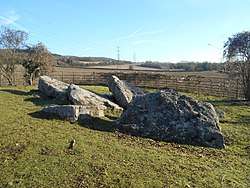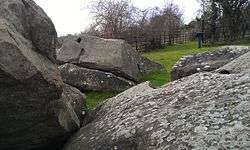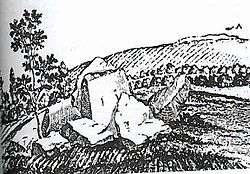Little Kit's Coty House
The Countless Stones, also known as Little Kit's Coty House, is the name of the remains of a Neolithic chambered long barrow on Blue Bell Hill near Aylesford in the English county of Kent. The site is one of the Medway megaliths. Their name comes from an old wives' tale that every time you count the stones, the result will be different.


Now a jumble of half-buried sarsen stones it is thought to have been a tomb similar to that of the Coldrum Stones. The name is derived from the belief that the chaotic pile of stones from the collapsed tomb were uncountable and various stories are told about the fate of those who tried. Another nearby site that may have been Neolithic is at Cossington.
There are between 19 and 21 stones depending on the authority. They were pushed over in the seventeenth century seemingly before any antiquarian interest was taken in them. William Stukeley attempted to reconstruct the damaged tomb in plan in the eighteenth century.

Archaeological evaluation trenching in 1989 found no clear evidence of any surrounding quarry ditch which would normally have been excavated to provide material for a covering barrow. Iron Age activity was found close by.
The better preserved Kit's Coty House stands around 450 metres (1,480 ft) north.
In 1893, the antiquarian George Payne mentioned the monument in his Collectanea Cantiana, describing it as a "fallen cromlech" and noting that there were various other megaliths scattered in the vicinity, suggesting that these were part of the monument or another like it, since destroyed.[1]
Several modern Pagan religions are practised at the Medway Megaliths, the most publicly visible of which is Druidry.[2] Research conducted among these Druids in 2014 revealed that some Druidic activity had taken place at Little Kit's Coty House but that at least one Druid disliked performing rituals there because of the noise produced by nearby power cables.[2]
References
Footnotes
- ↑ Payne 1893, pp. 126–127.
- 1 2 Doyle White 2016, p. 351.
Bibliography
- "Coldrum Stones". The National Trust. Retrieved 27 August 2012.
- Ashbee, Paul (1998). "Coldrum Revisited and Reviewed". Archaeologia Cantiana. Kent Archaeological Society. 118: 1&ndash, 44.
- Bennett, F.J. (January–June 1913). "Coldrum Monument and Exploration 1910". Journal of the Royal Anthropological Institute. 43: 76&ndash, 85. JSTOR 2843160.
- Burl, Aubrey (1981). Rites of the Gods. London: Weidenfeld & Nicolson. ISBN 978-0460043137.
- Clinch, George (1904). "Coldrum, Kent, and Its Relation to Stonehenge". Man. 4: 20&ndash, 23. JSTOR 2840863.
- Filkins, E. (1928). "Excavations at Coldrum, Kent". The Antiquaries Journal. 8: 356&ndash, 357. doi:10.1017/s0003581500092970.
- Grinsell, Leslie V. (1976). Folklore of Prehistoric Sites in Britain. London: David & Charles. ISBN 0-7153-7241-6.
- Hutton, Ronald (1991). The Pagan Religions of the Ancient British Isles: Their Nature and Legacy. Oxford, U.K. and Cambridge, U.S.: Blackwell. ISBN 978-0-631-17288-8.
- Keith, A. (January–June 1913). "Report on the Human Remains Found by F. J. Bennett, Esq., F.G.S., in the Central Chamber of a Megalithic Monument at Coldrum, Kent". Journal of the Royal Anthropological Institute. 43: 86&ndash, 100. JSTOR 2843161.
- Lewis, A.L. (1878). "On a Rude Stone Monument in Kent". The Journal of the Anthropological Institute of Great Britain and Ireland. 7: 140&ndash, 142. JSTOR 2841379.
- Lewis, A.L. (1904). "The Coldrum Monument". Man. Royal Anthropological Institute of Great Britain and Ireland. 4: 395. JSTOR 2839987.
- Malone, Caroline (2001). Neolithic Britain and Ireland. Stroud, Gloucestershire: Tempus. ISBN 0-7524-1442-9.
- Payne, George (1893). Collectanea Cantiana: Or, Archæological Researches in the Neighbourhood of Sittingbourne, and Otherparts of Kent. London: Mitchell and Hughes.
- Petrie, W.M. Flinders (1880). "Notes on Kentish Earthworks". Archaeologia Cantiana. 13: 8&ndash, 16.
- Philp, Brian; Dutto, Mike (2005). The Medway Megaliths (third ed.). Kent: Kent Archaeological Trust.
- Smith, Martin; Brickley, Megan (2009). People of the Long Barrows: Life, Death and Burial in the Early Neolithic. Stroud: The History Press. ISBN 978-0752447339.
- Wright (1844). "Proceedings of the Committee". The Archaeological Journal. 1: 262&ndash, 264.
- S.P. Menefee, "The Countless Stones: A Final Reckoning," Folklore, vol. 86 (Autumn/Winter, 1975): pp. 146-66.
| Wikimedia Commons has media related to Little Kit's Coty House. |